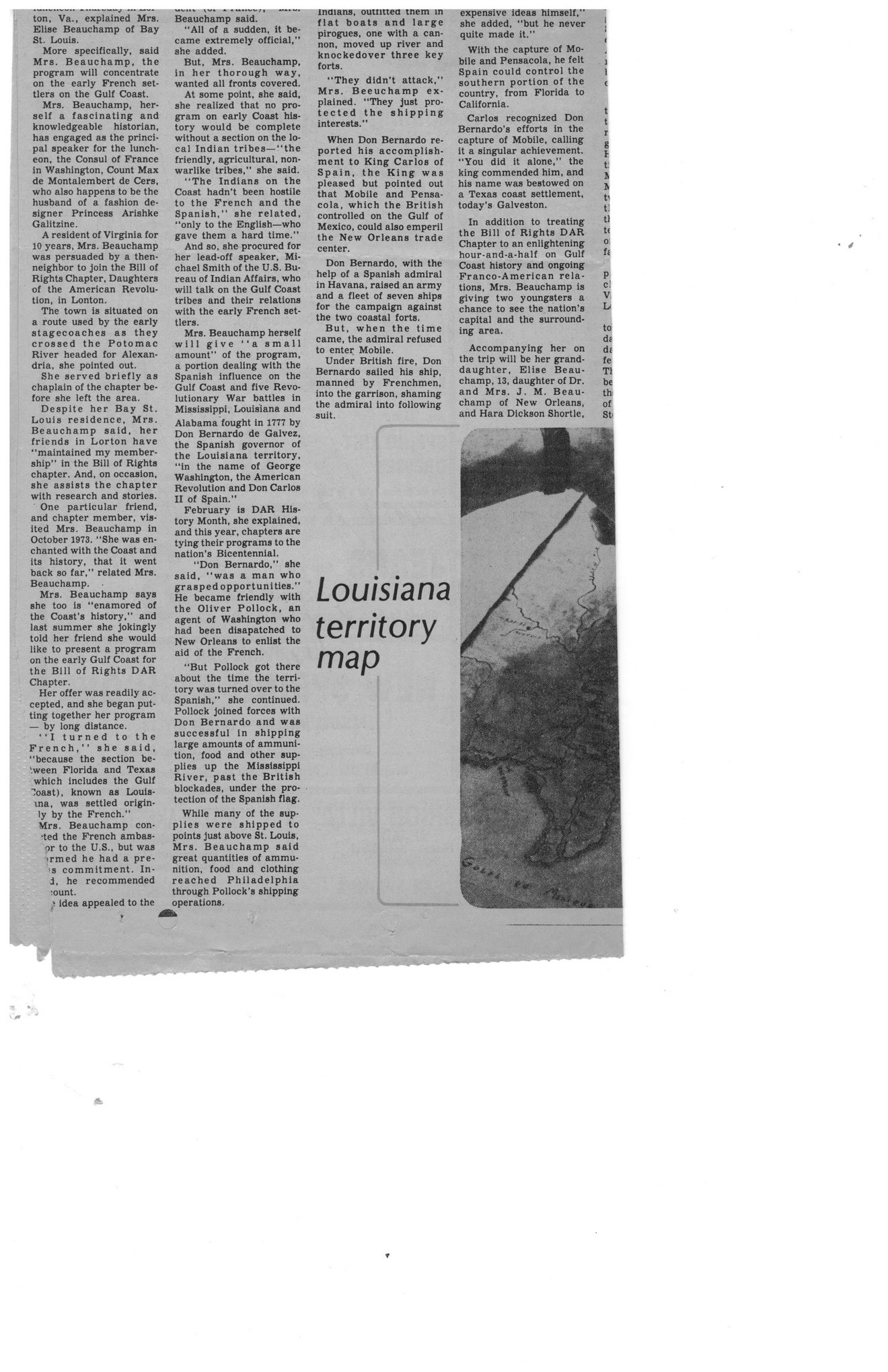This text was obtained via automated optical character recognition.
It has not been edited and may therefore contain several errors.
ton, Va., explained Mrs. Elise Beauchamp of Bay St. Louis. More specifically, said Mrs. Beauchamp, the program will concentrate on the early French settlers on the Gulf Coast. Mrs. Beauchamp, herself a fascinating and knowledgeable historian, has engaged as the principal speaker for the luncheon, the Consul of France in Washington, Count Max de Montalembert de Cers, who also happens to be the husband of a fashion designer Princess Arishke Galitzine. A resident of Virginia for 10 years, Mrs. Beauchamp was persuaded by a then-neighbor to join the Bill of Eights Chapter, Daughters of the American Revolution, in Lonton. The town is situated on a route used by the early stagecoaches as they crossed the Potomac River headed for Alexandria, she pointed out. She served briefly as chaplain of the chapter before she left the area. Despite her Bay St. Louis residence, Mrs. Beauchamp said, her friends in Lorton have "maintained my membership" in the Bill of Rights chapter. And, on occasion, she assists the chapter with research and stories. One particular friend, and chapter member, visited Mrs. Beauchamp in October 1973. “She was enchanted with the Coast and its history, that it went back so far,” related Mrs. Beauchamp. Mrs. Beauchamp says she too is "enamored of the Coast’s history,” and last summer she Jokingly told her friend she would like to present a program on the early Gulf Coast for the Bill of Rights DAR Chapter. Her offer was readily accepted, and she began putting together her program — by long distance. ‘‘I turned to the French,’’ she said, "because the section between Florida and Texas which includes the Gulf ^oast), known as Louis-ma, was settled origin-ly by the French.” Mrs. Beauchamp con-•ted the French ambas-pr to the U.S., but was >rmed he had a pre-'s commitment. In- 3, he recommended :ount. ^ idea appealed to the Beauchamp said. “AH of a sudden, it became extremely official," she added. But, Mrs. Beauchamp, in her thorough way, wanted all fronts covered. At some point, she said, she realized that no program on early Coast history would be complete without a section on the local Indian tribes—“the friendly, agricultural, nonwarlike tribes,” she said. "The Indians on the Coast hadn't been hostile to the French and the Spanish," she related, “only to the English—who gave them a hard time.” And so, she procured for her lead-off speaker, Michael Smith of the U.S. Bureau of Indian Affairs, who will talk on the Gulf Coast tribes and their relations with the early French settlers. Mrs. Beauchamp herself will give ‘‘a small amount” of the program, a portion dealing with the Spanish influence on the Gulf Coast and five Revolutionary War battles in Mississippi, Louisiana and Alabama fought in 1777 by Don Bernardo de Galvez, the Spanish governor of the Louisiana territory, "in the name of George Washington, the American Revolution and Don Carlos II of Spain.” February is DAR History Month, she explained, and this year, chapters are tying their programs to the nation’s Bicentennial. “Don Bernardo," she said, ‘‘was a man who grasped opportunities." He became friendly with the Oliver Pollock, an agent of Washington who had been disapatched to New Orleans to enlist the aid of the French. “But Pollock got there about the time the territory was turned over to the Spanish,” she continued. Pollock joined forces with Don Bernardo and was successful in shipping large amounts of ammunition, food and other supplies up the Mississippi River, past the British blockades, under the protection of the Spanish flag. While many of the supplies were shipped to points just above St. Louis, Mrs. Beauchamp said great quantities of ammunition, food and clothing reached Philadelphia through Pollock’s shipping operations. Indians, ouinuea mem in flat boats and large pirogues, one with a cannon, moved up river and knockedover three key forts. "They didn’t attack," Mrs. Beeuchamp explained. "They just protected the shipping interests." When Don Bernardo reported his accomplishment to King Carlos of Spain, the King was pleased but pointed out that Mobile and Pensacola, which the British controlled on the Gulf of Mexico, could also emperil the New Orleans trade center. Don Bernardo, with the help of a Spanish admiral in Havana, raised an army and a fleet of seven ships for the campaign against the two coastal forts. But, when the time came, the admiral refused to enter Mobile. Under British fire, Don Bernardo sailed his ship, manned by Frenchmen, into the garrison, shaming the admiral into following suit. Louisiana territory map expensive Tdeas Tiimself," she added, “but he never quite made it.” With the capture of Mobile and Pensacola, he felt Spain could control the southern portion of the country, from Florida to California. Carlos recognized Don Bernardo’s efforts in the capture of Mobile, calling it a singular achievement. "You did it alone," the king commended him, and his name was bestowed on a Texas coast settlement, today’s Galveston. In addition to treating the Bill of Rights DAR Chapter to an enlightening hour-and-a-half on Gulf Coast history and ongoing Franco-American relations, Mrs. Beauchamp is giving two youngsters a chance to see the nation’s capital and the surrounding area. Accompanying her on the trip will be her granddaughter, Elise Beauchamp, 13, daughter of Dr. and Mrs. J. M. Beauchamp of New Orleans, and Hara Dickson Shortle, l 1 c t t p 8 fc ti 5 H t1 t! U t< o: f« P c! V; U ta dt d£ fe Tl b< th of St A T

Hancock County History General Newspaper Clippings Elise-Beauchamp-DAR-(2)